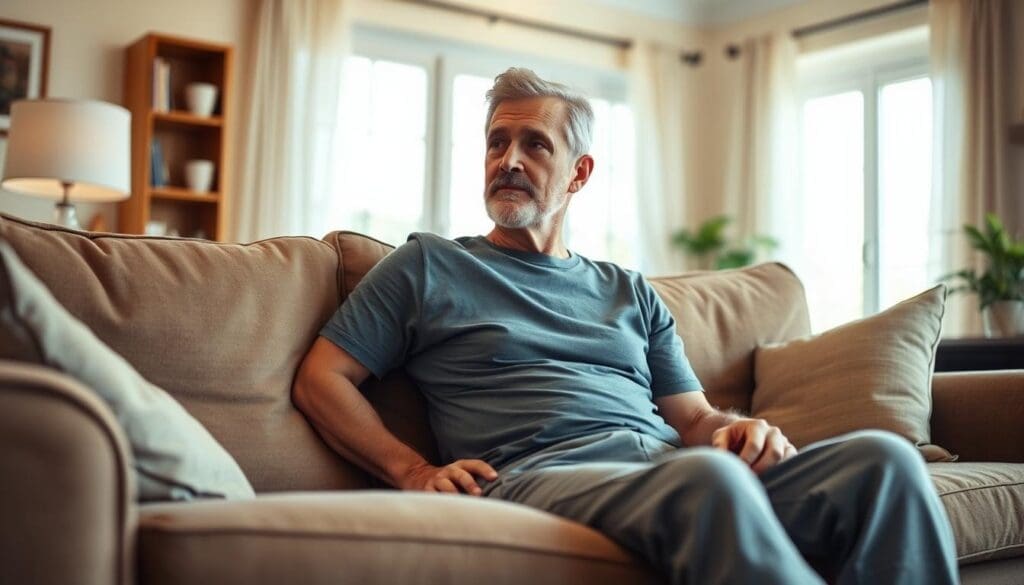Last Updated on November 27, 2025 by Bilal Hasdemir

Surviving prostate cancer starts a new chapter for over 1 million men each year. Studies show that early detection and modern treatments lead to high remission rates. This means more men can live long, healthy lives after treatment.
At Liv Hospital, we know beating cancer is a big win. But, thriving after it takes more than just winning the battle. It needs expert care, strength, and a clear plan for recovery. We’re here to help every step of the way, with top-notch support and care.
We aim to give the best medical care using the latest, proven methods. We keep improving our care to help patients from around the world get the best healthcare.

Survivors of prostate cancer face many challenges as they move on from treatment. They must adjust to the long-term effects of the disease and its treatment. This new reality is complex, involving physical, emotional, and psychological changes.
Prostate cancer is a common disease among men, affecting many survivors worldwide. After treatment, survivors often experience physical and emotional changes. These changes can impact their quality of life.
A study in the Journal of Clinical Oncology found survivors dealing with urinary incontinence, erectile dysfunction, and psychological distress. It’s important to understand these challenges to offer the right support.
| Common Challenges | Percentage of Survivors Affected |
| Urinary Incontinence | 30-50% |
| Erectile Dysfunction | 40-80% |
| Psychological Distress | 20-40% |
“The journey after prostate cancer treatment is not just about recovery; it’s about rediscovering life and finding new ways to thrive.” – An Oncologist
Going from patient to survivor is a big step. It’s not just about getting better physically. It’s also about emotional and psychological adjustment. Survivors must deal with follow-up care, late effects, and rebuilding their lives.
It’s crucial to have effective coping strategies during this time. This can include getting help from healthcare providers, joining support groups, and living a healthy lifestyle. These actions can help improve overall wellbeing and quality of life.
Survivors often find new opportunities for growth and purpose. By understanding the challenges and using available resources, they can lead meaningful lives after their diagnosis.

Life after prostate cancer treatment brings changes and a recovery timeline to understand. Men may face urinary incontinence and sexual function changes. Our team helps manage these side effects to improve quality of life.
Survivors may see many physical changes after treatment. Urinary incontinence is common, but most regain bladder control over time. Pelvic floor rehabilitation exercises help a lot.
Changes in sexual function are also common. But, medical therapies and strategies can improve sexual health.
Other changes include fatigue, hot flashes, and bowel habit changes. Knowing these side effects and how to manage them is key for a smooth recovery.
The recovery time varies, but most men see big improvements in the first year. Early recovery (first 3-6 months) focuses on managing side effects and starting rehab. As time goes on, most men see more improvement, with many recovering fully in 1-2 years.
It’s vital for survivors to stay in touch with their healthcare team. This way, they can monitor progress and tackle any issues that come up during recovery.
Prostate cancer treatment can affect how you use the bathroom. But, there are ways to get back in control. Many men face urinary incontinence after treatment. Yet, most can learn to control their bladder again with the right help.
Incontinence can happen if treatment damages the muscles and nerves that help you pee. How bad and long-lasting it is can vary. It depends on the treatment and your health.
We help our patients figure out why they’re incontinent. Then, we create a plan just for them.
Rehabbing the pelvic floor is key to better bladder control. Kegel exercises are a big help. They make the pelvic floor muscles stronger.
We also use biofeedback and electrical stimulation to aid in recovery. Research shows these methods work well. They help men regain control over their bladder and improve their life quality.
It’s important for men to get a personalized rehab plan. By mixing medical treatments with pelvic floor exercises, most men see big improvements in their bladder control.
Sexual health and intimacy are key parts of life that prostate cancer treatment can affect. Survivors often face changes in sexual function. These changes can impact their relationships and overall wellbeing.
Prostate cancer treatment can cause physical changes like erectile dysfunction and lower libido. These changes can be tough for survivors and their partners. We suggest looking into adaptation strategies like counseling and support groups to help cope.
There are many medical and therapeutic options for sexual health issues after prostate cancer treatment. These include medications for erectile dysfunction, hormonal therapies, and sex therapy. We help survivors find the best options for their needs, focusing on emotional healing and coping strategies.
By tackling sexual health and intimacy, survivors can regain confidence and improve their relationships. We aim to provide full care for prostate cancer survivors. This includes access to support groups for extra guidance and community.
For prostate cancer survivors, improving nutrition and physical activity is key. Healthy habits, like a balanced diet and regular exercise, boost wellbeing. They also lower the chance of cancer coming back.
Research shows a healthy lifestyle can increase survival rates and improve life quality for prostate cancer survivors. We help our patients create personalized plans for better health and wellbeing.
A healthy diet is essential for recovery and living well after cancer. We suggest focusing on:
It’s also key to limit or avoid:
Regular exercise is vital for a healthy lifestyle. It helps manage side effects, improves physical function, and boosts emotional wellbeing.
Here are some exercise guidelines:
Always talk to your healthcare team before starting any new exercise. They can make sure it’s safe and right for you.
Recovering from prostate cancer is not just about getting better physically. It’s also about taking care of your emotional health. Survivors often face big emotional challenges, like fear of cancer coming back and stress. It’s key to tackle these feelings to heal fully.
Fear of cancer coming back is a big worry for many survivors. This fear can lead to anxiety, depression, or constant checking for symptoms. It’s vital to deal with this fear to heal emotionally. Effective coping strategies include keeping in touch with doctors, joining support groups, and trying mindfulness or meditation.
Survivors can also find help with cognitive-behavioral therapy (CBT). It helps change negative thoughts linked to fear of recurrence. Knowing about follow-up care and monitoring can also help ease worries.
Healing emotionally is a big part of being a survivor. Here are some ways to help:
By using these strategies, survivors can grow stronger emotionally and live better lives. We’re here to offer caring support every step of the way.
Creating a strong support network is key for prostate cancer survivors. It offers emotional, practical, and informational help. This support helps them deal with life after treatment.
Support groups are a safe place for survivors to share and get advice. Engaging with support groups can reduce feelings of loneliness. It also offers coping strategies. Look for groups that meet in person, online, or on social media to find what suits you.
When picking a support group, think about its focus, size, and leadership. Some groups are just for prostate cancer survivors. It’s important to choose one that fits your needs.
Getting family involved in recovery can make a big difference. Family members can offer emotional support and help with daily tasks. They also help keep survivors connected to their community. Encourage survivors to talk about their needs and involve family in support group activities.
Building a strong support network with support groups and family can help survivors overcome recovery challenges. Our team is dedicated to connecting patients with the resources they need to thrive.
The journey doesn’t end after prostate cancer treatment. A well-structured survivorship plan is vital for long-term recovery. It’s essential for ongoing health and wellbeing, helping prostate cancer survivors thrive beyond their diagnosis.
We work closely with our patients to develop personalized plans. These plans promote long-term health and wellbeing. They include follow-up care and monitoring protocols, as well as recognizing warning signs of recurrence.
Follow-up care is a critical aspect of a long-term survivorship plan. Regular check-ups and monitoring protocols help us detect any potential issues early. This ensures timely intervention. Prostate-specific antigen (PSA) testing is a crucial tool in monitoring for recurrence.
Our team recommends the following follow-up care schedule:
By adhering to this schedule, we can effectively monitor your health and address any concerns promptly.
Understanding the warning signs of recurrence is vital for prostate cancer survivors. While not exhaustive, being aware of the following symptoms can help you identify potential issues early:
If you experience any of these symptoms, it’s essential to contact your healthcare provider immediately. Early detection is key to managing recurrence effectively.
By being proactive and informed, you can take control of your health and wellbeing as a prostate cancer survivor.
Life after prostate cancer treatment is a journey that needs a full approach to recovery and survivorship. At Liv Hospital, we are dedicated to supporting patients every step of the way. By following the 7 key steps in this article, survivors can face the challenges of life after prostate cancer and thrive.
Survivor stories show that people can lead fulfilling and meaningful lives after treatment. Community resources are key in this journey, offering support and guidance. We encourage survivors to use these resources and build a strong support network.
With the right support and resources, survivors can beat the physical and emotional challenges of prostate cancer and thrive. We aim to provide top-notch healthcare with complete support for international patients. This helps them navigate life after prostate cancer and live a fulfilling life.
Survivors may face urinary incontinence, erectile dysfunction, and bowel habit changes. Liv Hospital helps manage these side effects. We create personalized rehabilitation plans to improve quality of life.
Recovery time varies by treatment type and individual factors. It can take months to a year or more. Our team helps develop a plan for overall health and wellbeing.
Kegel exercises can improve urinary control. Liv Hospital creates personalized plans to meet specific needs.
Our team offers sensitive care for sexual health and intimacy. We provide counseling and medication to adapt to physical changes and enhance quality of life.
Eating fruits, vegetables, and whole grains promotes health. Liv Hospital provides dietary recommendations tailored to individual needs.
Our team helps manage fear of recurrence and stress. We connect patients with support groups and resources for emotional healing.
A support network is key for emotional healing and wellbeing. Liv Hospital connects patients with support groups and involves family in recovery for a comprehensive support system.
A survivorship plan includes follow-up care and monitoring. Our team helps develop personalized plans for long-term health and wellbeing.
Following a comprehensive survivorship plan reduces recurrence risk. Liv Hospital guides on healthy lifestyle choices and monitoring for long-term health.
Subscribe to our e-newsletter to stay informed about the latest innovations in the world of health and exclusive offers!